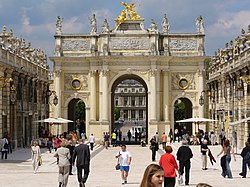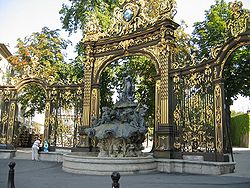Nancy, France
Nancy, France | |
|---|---|
 Place Stanislas - Fountain of Amphitrite | |
| Country | France |
| Arrondissement | Nancy |
| Canton | Chief town of 4 cantons |
| • Mayor | (PR/UMP) |
| Time zone | UTC+01:00 (CET) |
| • Summer (DST) | UTC+02:00 (CEST) |
| INSEE/Postal code | 54395 / |
Nancy (IPA: [nɑ̃si]; archaic German: Nanzig; Luxembourgish: Nanzeg) is a city and commune in the Lorraine région of northeastern France.
The city is the préfecture (capital) of the Meurthe-et-Moselle département. The metropolitan area (aire urbaine) of Nancy had a population of 410,509 inhabitants at the 1999 census, 103,602 of whom lived in the city of Nancy proper (105,100 inhabitants in the city proper as of 2004 estimates).
History
The earliest signs of human settlement in the area date back to 800 BC. Early settlers were likely attracted by easily mined iron ore and a ford in the Meurthe River. A small fortified town named Nanciacum (Nancy) was built by Gerard, Duke of Lorraine around 1050.
Nancy was conquered by Emperor Frederick II in the 13th century, then rebuilt in stone over the next few centuries as it grew in importance as the Capital of the Duchy of Lorraine. Charles the Bold, Duke of Burgundy, was defeated and killed in the Battle of Nancy in 1477.
With the death of Duke Stanislas in 1766, the duchy became a French province and Nancy remained its capital.
As unrest surfaced within the French armed forces during the French Revolution, a full-scale mutiny took place in Nancy in later summer 1790. A few reliable units lay siege to the town and shot or imprisoned the mutineers.
In 1871, Nancy remained French when Prussia invaded Alsace-Moselle. The flow of refugees reaching Nancy doubled its population in three decades. Artistic, academic, financial and industrial excellence fostered, setting what is still the Capital of Lorraine's trademark nowadays.
Nancy was freed from Nazi Germany by the U.S. Third Army in September 1944, during the Lorraine Campaign of World War II (see Battle of Nancy (1944)).
In 1988, Pope Jean-Paul II visited Nancy. In 2005, French President Jacques Chirac, German Chancelor Gerard Schröder and Polish President Aleksander Kwaśniewski inaugurated the renovated Place Stanislas.
Geography
The neighboring communes of Nancy are: Jarville-la-Malgrange, Laxou, Malzéville, Maxéville, Saint-Max, Tomblaine, Vandœuvre-lès-Nancy, and Villers-lès-Nancy.
Sights
The Place Stanislas[1] named after the king of Polish-Lithuanian Commonwealth and duke of Lorraine Stanisław Leszczyński, Place de la Carrière, and Place d'Alliance were added on the World Heritage Sites list by the UNESCO in 1983.
The "École de Nancy", a group of artists and architects founded by the glassmaster and furniture maker Émile Gallé, worked in the Art Nouveau style at the end of the 19th century and the early 20th century. It was principally their work which made Nancy a centre of art and architecture that rivaled Paris and helped give the city the nickname "Capitale de l'Est." The city still possesses many Art Nouveau buildings (mostly banks or private homes). Furniture, glassware, and other pieces of the decorative arts are conserved at the Musée de l'École de Nancy, which is housed in the 1909 villa of Eugène Corbin, a Nancy businessman and supporter of the Art Nouveau there.
The old city centre's heritage dates from the Middle Ages to the 18th century. The cathedral of Nancy is a fine example of 18th century architecture. The surroundings of the train station are a busy commercial area.
There is also a botanical garden in Nancy, "Le Jardin Botanique". It is open from 10 am to 12 (noon), and from 2 pm to 5 pm on Mondays through Fridays. On Saturdays and Sundays it is open from 2 pm to 5 pm. It costs around 2.30 euros to enter, and has many different types of plants, including tropical, and many other wonderful types of plants and flowers.
There is also the aquarium and various other public gardens and places of interest including the Pépinière and Parc Sainte-Marie (public gardens); the Musée de l'École de Nancy, the Musée des Beaux-Arts and the Musée Lorrain amongst others.
Culture
The city is known for this World Heritage buildings : The Place Stanislas (XVIII°) which was opened April 2005 by Jacques Chirac after refurbishment.
At the turn of the 20th century, Nancy was a major centre of the Art Nouveau with the school of Nancy. The city possess a unique and interesting Musée de l'École de Nancy (School of Nancy Museum) with artworks from Émile Gallé, Louis Majorelle, Daum crystals...
Nancy also possesses many museums :
- Museum of Fine-Arts of Nancy with painters from XV° to XX° centuries, and a huge collection of Daum (studio) crystals shown in old fortifications of city.
- Lorraine History Museum dedicated to the history of the Duchy of Lorraine and arts (Jacques Callot collection, Georges de La Tour...).
- Aquarium and Natural History Museum of Nancy.
The city is also the seat of the Diocese of Nancy and the home of the Opéra national de Lorraine.
Transport
Nancy is served by a 'tramway on tyres', actually a guided busway based on Bombardier Transportation's Guided Light Transit technology. It has suffered many incidents and malfunctions, but now works without significant problems. This system is also used in Caen, and will be installed in the city of Nijmegen.
Universities and colleges
This is a list of institutions of higher learning in Nancy.
- Henri Poincaré University (Université Henri Poincaré, UHP, also known as Nancy 1) [2]
- Nancy 2 University (Université Nancy 2) [3]
- National Polytechnic Institute of Lorraine (Institut National Polytechnique de Lorraine or INPL)
- École des Beaux-Arts de Nancy
- École nationale supérieure des industries chimiques (ENSIC)
- École nationale supérieure en génie des systèmes industriels (ENSGSI)
- École nationale supérieure d'électricité et de mécanique (ENSEM)
- École nationale supérieure des Mines de Nancy
- École Supérieure des Sciences et Technologies de l'Ingénieur de Nancy (ESSTIN)
- École Supérieure d'Informatique et Applications de Lorraine (ESIAL)
- Institut commercial de Nancy (ICN Nancy)
- Sciences Po Paris (French-German Undergraduate Campus) [4]
Universities contribute to Nancy's prestigious atmosphere making it reach the top of many "Quality of Life" rankings by the French press. As figures demonstrate, Nancy is among France's largest cities :
- nb.1 Largest ratio of students (21%), ahead of Lille
- nb.2 Highest rate of executives (25%), after Paris
- nb.2 Highest ratio of doctors in medecine, after Montpellier
- nb.3 Largest protected architectural old town
- nb.3 Highest rate of graduates
- nb.4 Highest rate for movie theatre attendance
- nb.5 Highest income per capita, after Paris/Ly./Bx/Nantes
- nb.5 Largest absolute number of students
- nb.6 For sports (L'Equipe)
- nb.8 Less congested traffic
- nb.9 Cheapest real estate
- nb.9 Lowest unemployment rate
- nb.10 Safest city
- nb.10 Cleaner air
Sports
Nancy is home to two of the three profesional sport clubs in Lorraine: AS Nancy-Lorraine in football, and SLUC Nancy in basketball (the third one is 2nd league [FC Metz]).
AS Nancy-Lorraine's Hall of Fame includes triple-Ballon d'Or and Uefa President Michel Platini, Arsenal manager Arsène Wenger, 1998 World Champion Aimé Jacquet, 2000 European Champion Roger Lemerre, 1998 African Ballon d'Or Mustapha Hadji, Irish legend Tony Cascarino, 1986 European Cup winner Sacha Zavarov and 1958 World Cup Semi-finalist Roger Piantoni.
SLUC Nancy won the last Korac European Cup in 2002 and became Champion of France in 2008.
Miscellaneous



The N ray, which turned out to be a figment of local physicist René-Prosper Blondlot's imagination, was named for Nancy.
Nancy's archaic German name is Nanzig, and a similar form Nanzeg is still used in Luxembourgish.
The motto of the city is Non inultus premor, Latin for "No one touches me with impunity". This is very similar to the Scottish motto Nemo me impune lacessit, and both are references to the thistle, which is a symbol of both Scotland and Lorraine.
Native sons and daughters
Nancy was the birthplace of:
- Christina, Grand Duchess of Tuscany (1565-1637)
- Éric Rohmer (b. 1920), film director
- Jacques Callot (c.1592-1635), baroque graphics artist, draftsman and printmaker
- Paul Colin (1892 - 1985), poster artist
- Louis Maimbourg (1610-1686), Jesuit and historian
- Francis I, Holy Roman Emperor (1708-1765), duke of Lorraine and later Holy Roman Emperor
- Jean François de Saint-Lambert (1716-1803), poet
- Joseph Ducreux (1735-1802), portrait painter, pastelist, miniaturist, and engraver
- Antoine Drouot (1774-1847), one of Napoleon's generals
- Edmond de Goncourt (1822-1896), author, critic, publisher, founder of the Académie Goncourt
- Marie Henri d'Arbois de Jubainville (1827-1910), historian and philologist
- Émile Gallé (1846-1904), Art Nouveau artist
- René-Prosper Blondlot (1849-1930), physicist, best remembered for his mistaken identification of N rays
- Aimé Morot (1850-1913), painter
- Henri Poincaré (1854-1912), mathematician, theoretical scientist and philosopher of science
- Hubert Lyautey (1854-1934), Marshal of France
- Lucien Febvre (1878-1956), historian
- Henri Cartan (b. 1904), mathematician
- Pierre Schaeffer (1910-1995), noted as the inventor of musique concrète
- François Jacob (b. 1920), biologist
- Pascal Dusapin (b. 1955), composer
- Najoua Belyzel (b. 1981) singer
- Matthieu Delpierre (b. 1981), footballer
- Jean-Baptiste Isabey (1767-1855), painter
- Lucien Weissenburger (1860-1929), architect
- (François-)Emile André (1871-1933), architect
- Arnaud Vincent (b. 1974), motorcycle racer
- Michel Platini (b. 1955 in Joeuf), football legend
Hometown of these fictional characters
- René François Artois ('Allo 'Allo)
- René Artois ('Allo 'Allo [Twin brother of René François Artois])
- Madame de Verquin A fictional libertine in Marquis de Sade's short story Florville and Courval.
Sister cities
 - Newcastle, United Kingdom (since 1954)
- Newcastle, United Kingdom (since 1954) - Liège, Belgium (since 1954)
- Liège, Belgium (since 1954) - Karlsruhe, Germany (since 1955)
- Karlsruhe, Germany (since 1955) - Padua, Italy (since 1964)
- Padua, Italy (since 1964) - Kanazawa, Japan (since 1973)
- Kanazawa, Japan (since 1973) - Qiryat Shemona, Israel (since 1984)
- Qiryat Shemona, Israel (since 1984) - Lublin, Poland (since 1988)
- Lublin, Poland (since 1988)
 - Cincinnati, United States (since 1991)
- Cincinnati, United States (since 1991)
Notes
See also
- Battle of Nancy (1944) - The American World War II operation to liberate Nancy.
- Hunting of Jean-Baptiste, a famed wolf-hunt that began in Nancy
External links
- Template:Fr icon City council website
- Template:En icon Tourist office website
- Photographs of Nancy by Gregory Jacquier
- Place Stanislas Nancy
- Place Stanislas Live Webcam
- Template:Fr icon Young European Federalists in Nancy and around in Lorraine
- Template:Fr icon Botanical Gardens


